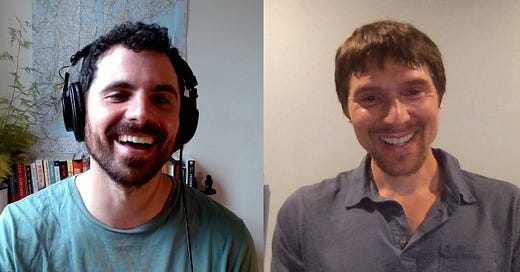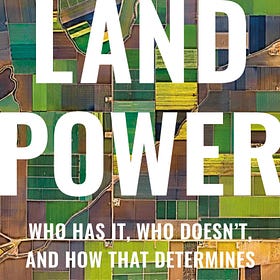In Land Power: Who Has It, Who Doesn’t, and How That Determines the Fate of Societies, Professor Michael Albertus (University of Chicago) explores how land has changed hands since the French Revolution. In places like the U.S., Canada, and Brazil, this “reshuffling” has shaped social hierarchies and the climate (spoiler: not in a good way). Today, signs point to us entering a new period of reshuffling. While there are risks of inequality deepening, Professor Albertus also sees opportunities to correct the mistakes of the past.
A condensed transcript of our conversation, edited for clarity, is below. You can also listen to us on the Skipped History podcast:
Ben: To begin, can you talk about what you call the Great Reshuffle?
MA: Sure. By 1789, the time of the French Revolution, it's hard to overstate how concentrated landholding was in Europe, Latin America, and much of East Asia. Populations were also starting to expand quite substantially. 1800 is when the global population surpassed one billion people for the first time. (Today we’re at eight billion.)
So demand for land increased, as did the ability of governments to reallocate it. That combination caused dramatic upheavals in who holds the land in societies across the globe. I call that era the Great Reshuffle because land redistribution, reallocation, and reshuffling came to characterize just about every country on earth.
Ben: Just to contextualize how the value of land has expanded since then, you place it now at around $200 trillion, greater than the value of all global economic output.
MA: No other form of wealth comes close.
Ben: Well, you haven’t seen my Beanie Baby collection.
MA: It must be pretty deep.
Ben: In my mind, it's worth at least a few hundred trillion dollars.
MA: Ha, I stand corrected!
Ben: Let’s go into some examples of land appropriation.
You talk at length about Palm Springs. There, you write, “Land reallocation put white settlers and entrepreneurs at the top.” Can you explain more?
MA: As settlement moved from the eastern seaboard in the United States through the Midwest and the South, then eventually to the West, we saw major dispossession of Indigenous groups from their land. That occurred in Palm Springs as well.
While many people today think of Palm Springs as a sort of playground for the rich and famous, it has a deep history rooted in the reallocation and appropriation of land. It began when the U.S. acquired land in the aftermath of the Mexican-American War. Very soon after, prospectors started moving west to seek gold and to mine and the like. The Palm Springs area and the Cahuilla Nation, an Indigenous community, got caught up in that.
In 1852, they were forced into a lopsided treaty that ceded much of their land. Later, the federal government gave the Southern Pacific Railway a right of way through the remainder of their land, breaking down tribal cohesion. As occurred around the country, the changes in land ownership and stewardship facilitated a flip toward a racial hierarchy in which settlers were at the top, which, in many ways, we still see in place today.
Ben: Canada has a related history of Indigenous dispossession, but theirs also includes “one of the greatest wealth transfers to men in human history.” This blew my mind. Can you talk more about that transfer?
MA: Yes, it occurred around a similar time period, in 1872, with something called the Dominion Lands Act.
Shortly after Canada gained independence from Britain, they were trying to settle the entirety of Western Canada, really from Ontario all the way west. Of course, there were Indigenous peoples living on that land, too. One significant difference between the U.S. and Canada though is that unlike in the U.S., Canada did not allow single women to homestead.
So with only a few exceptions, essentially all of Western Canada between 1872 and the 1930s, 1940s—we’re talking hundreds of millions of acres of land—went to men. Full stop.
Ben: That is a lot of emotional unavailability.
MA: Hard to fathom, right? But yeah, it was very extensive. This policy had all these consequences for Canadian society many, many decades later, and indeed up until the present day. If you think about women on the Canadian frontier, if their partner died or if they split up, they were often left high and dry and wouldn't have access to the land.
As I detail in the book, you see lots of revealing gender disparities in health, poverty, and more, reflective of differing rates of ownership in the land dating to this period.
Ben: You argue that land reshuffling in Canada “established a thick blanket of traditional conservative gender relations.” That notion reminded me of an argument from a book we covered a few weeks ago called What’s Left, by Malcolm Harris.
Malcolm writes that “women’s collective self-liberation from thousands of years of patriarchal domination... is one of the few existing social conflicts with the scale and potential to make a decisive progressive impact in the coming years.”
I think your insights about how that liberation might be tied to land are really important.
MA: I think that patriarchal pattern has repeated itself in society after society around the globe. And I should say that it's a big departure when you think about it from the perspective of broader human history. Ideas of domesticity are really tied to the development of agricultural societies, which led to gender differentiation in labor.
Ben: Right: a major point of yours is that a lot of these changes are tied to fairly recent developments. Related, it will surprise no one that environmental destruction is part of your book. You talk about “spiraling environmental destruction in Brazil” as one example.
MA: Yes, Brazil is another place where, in the aftermath of colonization, there was extremely unequal landholding. In the 1960s, a democratically elected government advocated for breaking up large estates. Unsurprisingly, landowners were adamantly against that idea and teamed up with the military to topple the government and come up with an alternative.
Their plan was to send people to a new frontier: the Amazon. “Nobody” was living there, right? (I place heavy emphasis on those quotation marks—there were widely dispersed Indigenous groups.) So the military opened up settlements in the Amazon. Trying to drop people into the middle of the jungle wasn’t the best idea, but over time, they created more infrastructure, like roads and markets, and those initial settlements started to grow.
Ben: Highways, my bugaboo, are an important part of this history, too.
You talk about the Trans-Amazonian Highway, construction of which began in 1970, and how it “cut like a dagger straight through the forest.” The highway soon led to more development that quickly “outpaced what planners had imagined and what the government had officially sanctioned.”
MA: It's remarkable. And if you look at patterns of deforestation in Brazil, some of the heaviest sites are centered around these communities that were established as alternatives to breaking up large landholdings. My point is that the structure of societies today is often tied to decisions made around land, and those decisions have big implications. In the case of the Amazon, we’re all affected by deforestation and its effects on climate change.
There's still a lot of pristine forest left, of course, but we're on a treadmill that’s hard to turn off in terms of developing the area. Many people’s livelihoods are now rooted in the region.
Ben: You finish the book by saying we’re “closer to the next reshuffle than we realize.” It certainly seems like we might already be there with the U.S. securing mineral rights in Ukraine, and the Trump administration's eagerness for land deals in the Middle East, Panama, and Greenland.
What does previous land reshuffling suggest about future reshuffling? Can we do it more justly?
MA: A key dynamic is that the global population is growing at a time when climate change is advancing. We see some consequences firsthand: supercharged hurricanes, the wildfires in L.A. Others are further away, like the melting of the permafrost and the warming of places like Canada and Russia. Critically, the melting of Arctic ice opens up new global shipping routes to the north of Russia and Canada that go alongside Greenland, making it a more geo-strategically attractive territory.
Ben: Plus, possibly the next wine country.
MA: Ha, there you go. As climatic changes occur, as more rare earth minerals are potentially available to fuel new generations of technology, whether it be AI or advanced chips, there’s another reshuffle in land. But I think there’s room for this reshuffle to be different than the last one.
In a world where climate change is worsening and populations are expanding, inequity and hierarchy will be exacerbated. At the same time, if you think about what the Canadian and Australian governments are doing in terms of trying to co-manage spaces and resources with Indigenous or First Nations peoples; if you think about land restitution that's occurring in South Africa to try and address some of the problems of apartheid; these changes also present opportunities to address the problems of land reshuffles prior, and I think we have to be ready to seize them.








